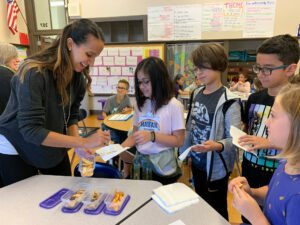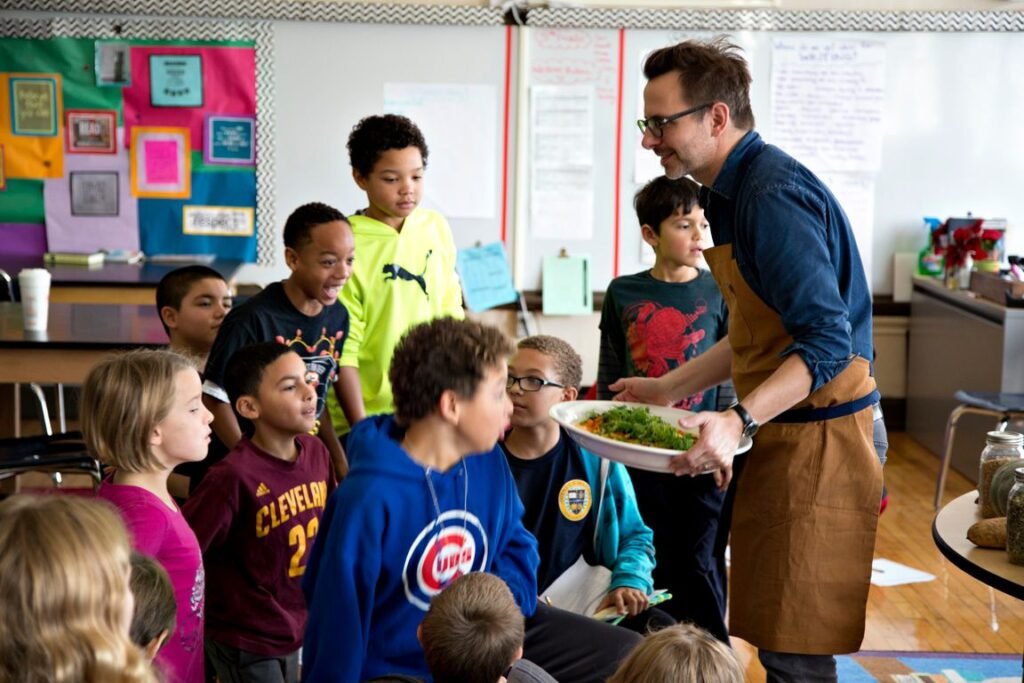Why Food Education Should Be on the Menu in U.S. Schools
And How Pilot Light is Illuminating The Way For Teachers Across The Country
Shilpa Gadhok, Founder & CEO
A one-hour conversation with Judith Martin is all you need to understand how important the role of food education is in building not only a sustainable food future but also a more inclusive world. As the global population tracks toward nine billion by 2050, challenges across our food production and sourcing, especially as it relates to global public health and environmental impacts will be at the forefront of some of our greatest private and public sector challenges. Mrs. Martin is the Assistant Principal at Waters Elementary in Chicago, IL, and recently we sat down to talk about how she and her teaching colleagues are continually working to incorporate food education into their day-to-day curriculum through the help of Pilot Light, a national nonprofit organization focused on advancing food and agriculture education in U.S. school systems.
On the surface, it may seem like the level of instruction students receive on food habits in early to mid-childhood education in the U.S. is adequate, but take a closer look and you’ll notice the grey areas where not only are there loose requirements on what “food education” includes, but also the lack of organizational coordination and resources that enable a consistent development of healthy habits, understanding of food biodiversity, the broadening of cultural perspectives, and tools for sustainable food management. “We really don’t talk about the role that food plays in our lives in education,” says Mrs. Martin, and a deeper dive at the data would support that. While, according to the National Center for Education Statistics (NCES), “practically all public schools (99%) offer nutrition education somewhere within the curriculum,” nutrition education requirements are substantially lower across each grade level. For instance, only 50% of all schools have district or state-level requirements, 40% have these requirements for ninth and tenth graders, and only about 20% for eleventh and twelfth graders. Nutrition is also the main focus of any food education in U.S. schools today, and there is negligible evidence to support the instruction of concepts and implications going beyond that to help advance the learning of how food impacts our communities, economies, and environmental health.
Further, the coordination of structured food education and information is severely lacking. Research shows that coordinated nutrition education has not only the ability to present a more focused message to students, aiding the learning and retaining process, but it also helps build an integrated educational plan that progresses as the student grows, allowing for a deeper understanding of how our food system impacts not only personal health, but various aspects of societal, environmental, and economic dependencies. According to NCES, “the majority of public schools (61%) have no nutrition education coordination, meaning that each teacher is responsible for his or her nutrition lessons.” Additional statistics show that only about 9% of U.S. schools have one person within the school coordinating nutrition education, 24% coordinate via group or committee, and about 6% leverage outside help to coordinate.
Seeing the gap in the educational system, Mrs. Martin turned to Pilot Light’s Fellowship Program for inspiration and support. “To me, Pilot Light brought this urge to bring awareness as early as possible. The Fellowship introduced me to many chefs and organizations passionate about food education and food awareness. Having those contacts helped us with the tools to implement a variety of lessons in our classroom. And the Pilot Light lessons were always the lessons the students most looked forward to,” she recounts.

One of those lessons illustrated how food can bridge the gap between seemingly different groups and cultures. In her Ancient Civilizations course for 5th and 6th graders, Mrs. Martin focused on how different civilizations were formed based on similar food practices shared in different parts of the world. In another lesson, Mrs. Martin incorporated current events and issues surrounding Refugee Camps, the hardships families were experiencing in these camps, and why cooking a group meal helped bring people together during times of turmoil. “It helped reinforce that food is what connects us.” Seamlessly incorporating these principles into her existing learning plans is a tool she learned through Pilot Light’s Fellowship program.
Pilot Light, a non-profit co-founded in 2010 by renowned chefs, Matthias Merges, Jason Hammel, and Paul Kahan, was developed to create a world of knowledgeable and engaged changemakers for an equitable, sustainable, and accessible food future. To achieve this, the organization focuses on broadening access to quality food education in U.S. school systems by partnering directly with teachers and school districts to embed lessons into existing curriculums. In partnership with food and agricultural experts along with educational professionals, Pilot Light has developed a set of Food Education Standards that serve as the cornerstone of their lesson plans across K-12 education. However, recognizing that teachers already carry so much responsibility on their plate, the lessons and activities are specially crafted to be seamless to topics already being taught in the classroom and incorporate experiential teaching techniques proven to help students retain information while boosting engagement. “Working through the teachers is powerful because not only it is scalable requiring fewer funds, but it also allows the lessons to be tailored to students’ personal experiences, which makes the lessons much more impactful. Teachers understand their students and their life situations the best, and they also hold a high degree of trust with many of their students. By empowering our teachers to lead the lesson plans, we reach more students in meaningful ways with less disruption to their trusted routines,” explains Alexandra DeSorbo-Quinn, Executive Director at Pilot Light.
Going beyond the basics of nutrition education is vital, especially as overall food demand is projected to increase by over 50% by 2050 according to The World Resources Global Food Report, and yet, according to today’s numbers, more than 800 million people are hungry or malnourished. The question continues to remain- how can we educate, inform, and create innovative distribution streams to close this gap? Agriculture uses almost half of the world’s vegetated land, contributing to about 25% of annual greenhouse gas emissions. “Increasing food production in ways that respect human well-being and the environment presents enormous challenges,” the report articulates. Why does this matter when it comes to educating our children? Because as we look at the future of our food system, food habits, economic stability, and societal health, our children today will be in their prime adult years over the next 27 years, bearing much of the responsibility, as we do today, to address these challenges.
Mrs. Martin credits Pilot Light’s program with awakening the passion and needs in her and her fellow teaching colleagues to go beyond the standard learning principles and help her students ask tough questions. “There are people who are food insecure and don’t have the access we do. So, what can we do? What connections can we build in our community? I see my role as helping students ask the questions of how we can be active participants in a.) understanding the role that food plays b.) making sure that everyone has access to food in a sustainable way and c.) being good stewards of managing food?” In Mrs. Martin’s view, these questions build empathy and a sense of responsibility in students as they grow to be contributing members of society.

Ms. Kathleen Smallwood is a current member of Pilot Light’s Fellowship program at Waters Elementary and teaches 4th-grade students about food waste. Her main project involves working with the school’s cafeteria to take leftovers from the lunchroom and inspiring her students to use those ingredients to come up with a new delicious meal that can be shared amongst other students and staff in the school. They cook in their classroom every week. “Knowing that our 4th graders are taking ingredients within our building that would otherwise be thrown away and creating a meal with the understanding that this new meal can feed all of us, is impactful,” says Mrs. Martin. The teachers have also been reinforcing composting and the importance of putting food back into our communities for those who need it, which has emphasized a different degree of social and emotional learning for students. In fact, at Far Brook School in Short Hills, NJ, Megan Gottlieb, who teaches PreK through 4th grade, has also noticed a shift, “The level of engagement and empowerment regarding food issues changed in my students. Talking about food insecurity and access, in elementary school, we started having very powerful conversations around equity/access and our responsibilities around this,” she says.
Incorporating lessons about food and agriculture as it relates to personal nutrition, social constructs, equality and connection, and the environment is imperative as we build the future leaders of our globalized society. “It’s not something that we readily think about when we think of ‘academics,’ but we need to be able to function as humans outside of math, science, and social studies…and food is a common access point,” says Mrs. Martin. As she looks to the future, she wants her students to break bread with others, she mentions. She wants to see her students in a setting where they are sharing, conversing, breaking down their walls, and being vulnerable with each other – for that is how we build a more resilient, inclusive, sustainable, and empathetic world.
And what a world that would be.
Interested in getting involved and supporting food education in U.S. Schools? Connect with Pilot Light, support the mission HERE, or email info@pilotlightchefs.org.
The author serves on the advisory board of Pilot Light.





